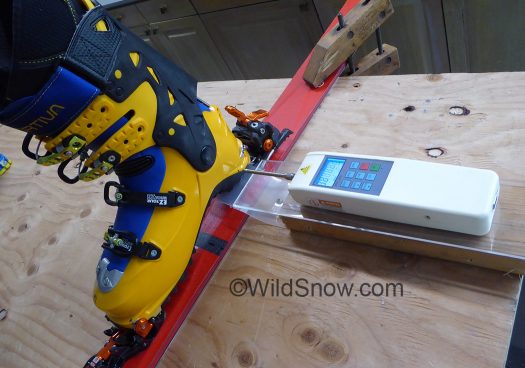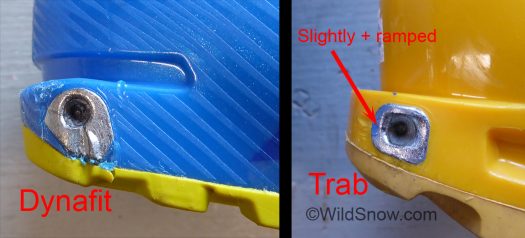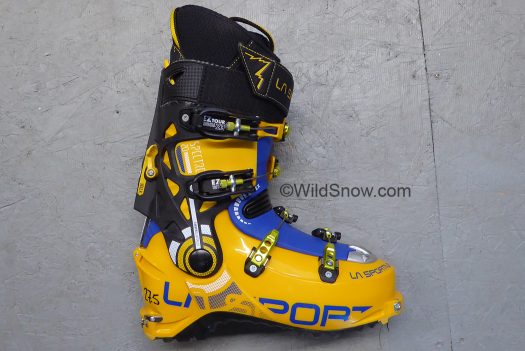See our review comparing Sportiva Spectre 1.0 and 2.0

So, boys and girls, we lashed up this rig using the G3 ION as it provides consistent release, and noticeably more clamping pressure than most other bindings, which makes them work well as a test bed. And yes that’s a real “force gauge” measurement instrument. As engineer Cam Shute of G3 says, “Don’t talk about it unless you can measure it.” I used this unit as a “push” gauge, with only my muscle power and a slide platform made from plexiglass to reduce friction. The heel of the boot is held by an anti-friction shim at the same level as if latched in downhill mode. Much of the variation in my data sets is no doubt due to using poorly regulated muscle power to push the gauge, but my results had obvious consistencies so I didn’t trouble with creating a mechanical force injector. BEAR IN MIND, this test was performed WITHOUT THE HEEL LATCHED to measure retention tension of the toe unit presumably related to the shape of the boot toe tech fittings.
The ski touring rumor factory: You could banshee scream “IT’s ALIVE” and you wouldn’t be far off the mark. As with any gossip, do not trust — verify like crazy before you base your credit card I/O or personal safety on what you hear muttered over the digi-waves. Today, case in point. Folks are questioning the performance of La Sportiva’s “hybrid” “tech-Trab” fittings (used in their Spectra 2.0 boot and others), designed to function with both “standard” tech bindings as well as Trab’s Attaco TR2. (Note, Trab has truly interesting bindings, check them out.)
If Albert Einstein was a freeride tour skier, he’d call the “TechTrab” fittings genius. Firstly, don’t fret whatsoever on the heel fittings. For a tech binding, they’re identical. It’s the toe where potential weirdness resides like an imaginary alien gray hovering over your sleeping form, contemplating an abduction for experimental shenanigans. Not to worry. Where the Trabuchian smarts come in is the Trab toe fittings test out beautifully. Smooth lateral release, no sticking or catching. According to our testing they do yield slightly less release resistance, on the order of a half a DIN number or so. For those of you who tend to dial up your settings, unnoticeable. But if you do precision DIN settings, be aware you’ll want to bump up your lateral tension a hair. Or better, as always, throw your skis on a test machine and see what your settings are actually yielding (reminder number 462: “DIN” numbers printed on ski bindings are just an approximation, for roughly setting release values “RV” before testing.)

Macro comparo señorio. Trab managed to make their fittings nearly identical to Dynafit’s in terms of release and retention performance. Lack of the Dynafit “Quick Step In” lead notch is not a deal breaker for ski touring, though the Quick Step is a nice feature for noobs. In our opinion, what makes the Trab offer slightly less toe retention is the tiny amount of additional ramp on the fitting, as shown above. That’s just a theory. I did measure the toe pin insertion depth of the ION, Sportiva came in at 92.03 mm wing width, with Dynafit new boot at 91.9, so they’re virtually identical at four tenths of a millimeter difference, which we assume is within manufacturing tolerances.
Also be aware that this slight reduction in retention force at the toe will influence how easily you can backcountry tour with your binding toes unlocked (something we enjoy doing with ION, for example). Indeed, while the percentage difference in release force is minimal when you’re in downhill mode, it’s more significant in touring mode where going unlocked with an ION might give you enough retention with a fully Dynafit clone toe fitting, but enough less retention with Spectre to result in you bending at the waist and locking them up, for the up.
Spreadsheet below. Don’t be alarmed by the percentage differences. Remember this is only for the toe, nearly all retention and release tension with a classic tech binding is provided by the heel. Again, our numbers indicate that while doing precision setting of release values you’ll want to increase your lateral release settings for Sportiva-Trab fittings at most 1/2 a DIN number. (And remember the heel fittings are identical in performance, so no change in vertical release.)
Also regarding the spreadsheet, please know that the “DIN” number is an approximation, as DIN is based on boot sole length and our 24 centimeter faux sole length is down on the lowest end of the DIN charts. On our favorite chart, a “twist” force of 20/23/26 Nm is DIN 2.5 with a ~24 centimeter boot sole. I used 24 centimeters as my push point as it resulted in enough force for my gauge to respond well, around halfway in the test instrument range of 0-200 Newtons. Pushing farther back towards the heel of the boot results in a longer lever arm and an easier test release, which I felt was too “loosy goosy” for my force gauge.
(If I’m off base when it comes to this DIN information, I’ll edit immediately, am waiting for confirmation from a mechanical engineer friend of mine.)
In summary, during bench testing the La Sportiva hybrid “trab-tech” toe fittings allowed smooth lateral release with no grabbing or sticking. They had around 1/2 a DIN number less retention than our sampling of other tech fittings, so if you’re fine tuning consider dialing up your lateral release setting accordingly. Those of you who bottom out your release settings or use higher ranges clearly need not make any changes, as the the higher your heel DIN settings are the percentage difference of toes becomes an influence too small to be a factor, in my opinion.

La Sportiva Spectre 2.0 is easily one of the better power-weight ratio shoes out there. This pair of 27.5 weights 1474 grams (52 ounces) per boot. You can remove the lower buckle, power strap and Trab heel fittings (if you don’t use Trab bindings) to trick out for big vertical uphill. We liked and reviewed Spectre 1.0, and like this one even better.
WildSnow.com publisher emeritus and founder Lou (Louis Dawson) has a 50+ years career in climbing, backcountry skiing and ski mountaineering. He was the first person in history to ski down all 54 Colorado 14,000-foot peaks, has authored numerous books about about backcountry skiing, and has skied from the summit of Denali in Alaska, North America’s highest mountain.
